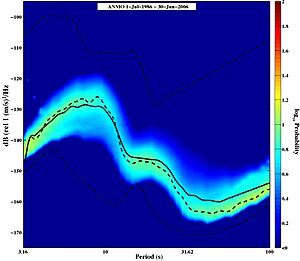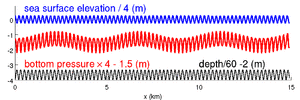Microseism facts for kids
A microseism is a very faint shaking of the ground, like a tiny earth tremor, that is caused by natural things happening on Earth. It's sometimes called an "Earth hum" because it's a constant, low-level vibration. These tiny tremors are mostly caused by ocean waves and waves in large lakes. Even though they are small, they can be recorded by special instruments called seismographs anywhere on Earth. Microseisms are a continuous shaking of the ground because ocean waves are always moving. The main types of seismic waves that make up microseisms are Rayleigh waves, but Love waves and other waves can also be part of it. The ground usually moves less than 10 micrometers (which is super tiny!) because the change from water waves to ground waves is very weak.
Contents
How We Detect Microseisms
Scientists have known for a long time that microseisms can be easily detected and measured using special tools called seismographs. These tools can record the tiny ground movements caused by ocean waves from anywhere on the planet.
The main microseism signals from the oceans usually have periods between about 4 to 30 seconds. This means a wave takes that long to complete one cycle. Microseismic noise often shows two main peaks, or times when the shaking is strongest.
The first, weaker peak is for longer periods, usually around 16 seconds. These are called primary microseisms. They happen when surface waves in shallow water push on the seafloor. These tremors have the same period as the water waves that create them.
The second, stronger peak is for shorter periods. These are called secondary microseisms. They happen when two ocean waves with similar frequencies but moving in opposite directions crash into each other. This creates a stronger pressure on the seafloor, and these tremors have a period that is half of the water wave period.
There's also a very slight, constant shaking of the Earth called the "Earth hum." This has much longer periods, from 30 to 1000 seconds. For periods up to 300 seconds, this vertical shaking is caused by Rayleigh waves that are generated when very long waves (called infragravity waves) interact with the ocean bottom. The main places where this "hum" comes from are likely along the edge of continental shelves, where the shallow ocean floor drops off into the deep ocean.
Because of all this, the seismic noise, from the short-period secondary microseisms to the long-period "hum," tells us a lot about the sea states (how rough or calm the ocean is). Scientists can use this information to figure out how ocean waves are behaving and how they change over time, from a few hours to many years. To use these signals well, we need to understand how microseisms are created.
How Primary Microseisms Are Made
The main way primary microseisms are made involves ocean waves interacting with the seafloor. Imagine ocean waves moving over the bottom of the ocean. When these waves hit the seafloor, they create pressure changes. If the seafloor has a slope or uneven parts, this interaction can generate seismic waves that travel through the Earth.
Since the pressure from ocean waves gets weaker very quickly as you go deeper into the water, primary microseisms mostly come from shallower parts of the ocean. This usually means depths less than a few hundred meters for waves that are 14-20 seconds long.
How Secondary Microseisms Are Made
Secondary microseisms are created when two groups of surface waves (like ocean swells) that are moving in different directions meet and interact.
If waves are moving in almost the same direction, they create wave groups that travel slower than the individual waves. For typical ocean waves that take about 10 seconds to pass, these groups move at about 10 meters per second.
However, if waves are moving in opposite directions, the wave groups they create travel much, much faster. If these fast-moving wave groups have a speed similar to seismic waves (between 1500 and 3000 meters per second), they can create acoustic-seismic waves that spread out through the Earth.
For seismic waves, the movement of ocean waves in deep water acts like a pressure pushing down on the ocean surface. This pressure is strongest when there's a lot of wave energy moving in opposite directions. This often happens when swells from one storm meet waves from another storm, or when waves hit the coast and reflect back.
The seismic noise recorded by a station on land can tell us about the ocean conditions close by (within a few hundred kilometers) or even across an entire ocean basin. To understand this noise, we need to know how these seismic waves travel.
Rayleigh waves make up most of the secondary microseism field. Both water and Earth particles move as these waves travel. The water layer is very important in how fast these waves move and how energy transfers from surface water waves to Rayleigh waves. The creation of secondary microseism Love waves involves changes caused by uneven seafloor and differences in how fast seismic waves travel inside the Earth.
Microseism Changes Over Seasons and Years
Microseisms change with the seasons, which gives us clues about what's happening on Earth's surface and deep inside. Microseisms that can be seen all over the world are made by ocean waves. Seasonal changes in the ocean and atmosphere, like wave height, storm activity, and wind patterns, cause these changes in how strong and how frequent microseisms are.
For example, during winter in the northern and southern hemispheres, there are usually more storms and stronger waves. Because of this, microseism signals become much stronger. In contrast, during summer, when the ocean and atmosphere are calmer, the microseism signal is at its weakest for the year. By studying these seasonal changes, scientists can better understand the processes that affect Earth's dynamic systems. Since ocean wave energy drives them, microseism signals around the Earth also show big differences in strength that reflect the average wave energy over large parts of the global oceans.
Studies over many decades have shown that microseism energy is actually increasing. This is because global storms and their waves are becoming stronger due to rising temperatures in the oceans and atmosphere, which is linked to anthropogenic global warming (human-caused climate change).
Body Wave Microseisms
Body wave microseisms are a type of seismic wave that travels through the Earth's inside, different from surface waves that mostly travel along the surface. These microseisms are created by various things, including changes in air pressure, interactions with the ocean, and human activities. Seasonal changes in body-wave noise have been noticed, matching the differences in storm activity between the northern and southern hemispheres.
Seismic recordings show that body wave microseisms, including P-waves, SV-waves, and SH-waves, can be seen at many different periods. P-wave microseisms are studied the most and are strongly connected to distant ocean storms. Scientists believe that complex interactions between surface ocean waves can create P-wave microseisms. SV-wave microseisms are also observed and can be explained by the same ideas as P-wave microseisms. However, SH-wave microseisms have been studied less, and how they are created is still a mystery. One recent idea suggests that a layer of sediment might be involved in their formation. Because we understand how body wave microseisms are made, they can be used to monitor ocean waves and even track tropical cyclones using seismic recordings.
See also
- Microbarom
- Earthquake
- Seismic noise
- Wind wave





